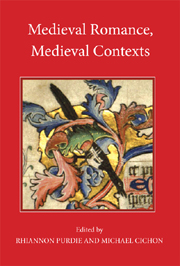Book contents
- Frontmatter
- Contents
- Acknowledgements
- Contributors
- Abbreviations
- Introduction: Romance and its Medieval Contexts
- 1 The Pleasure of Popular Romance: A Prefatory Essay
- 2 Representations of Peasant Speech: Some Literary and Social Contexts for The Taill of Rauf Coilyear
- 3 ‘As ye have brewd, so shal ye drink’: the Proverbial Context of Eger and Grime
- 4 Ekphrasis and Narrative in Emaré and Sir Eglamour of Artois
- 5 What's in a Name? Anglo-Norman Romances or Chansons de geste?
- 6 ‘For Goddes loue, sir, mercy!’: Recontextualising the Modern Critical Text of Floris and Blancheflor
- 7 Roland in England: Contextualising the Middle English Song of Roland
- 8 Romance Baptisms and Theological Contexts in The King of Tars and Sir Ferumbras
- 9 Modern and Medieval Views on Swooning: the Literary and Medical Contexts of Fainting in Romance
- 10 Walking (between) the Lines: Romance as Itinerary/Map
- 11 Romances of Continuity in the English Rous Roll
- 12 ‘Ex Libris domini duncani / Campbell de glenwrquhay/ miles’: The Buik of King Alexander the Conquerour in the household of Sir Duncan Campbell, seventh laird of Glenorchy
- 13 ‘Pur les francs homes amender’: Clerical Authors and the Thirteenth-Century Context of Historical Romance
- Index
- Volumes already published
4 - Ekphrasis and Narrative in Emaré and Sir Eglamour of Artois
Published online by Cambridge University Press: 12 September 2012
- Frontmatter
- Contents
- Acknowledgements
- Contributors
- Abbreviations
- Introduction: Romance and its Medieval Contexts
- 1 The Pleasure of Popular Romance: A Prefatory Essay
- 2 Representations of Peasant Speech: Some Literary and Social Contexts for The Taill of Rauf Coilyear
- 3 ‘As ye have brewd, so shal ye drink’: the Proverbial Context of Eger and Grime
- 4 Ekphrasis and Narrative in Emaré and Sir Eglamour of Artois
- 5 What's in a Name? Anglo-Norman Romances or Chansons de geste?
- 6 ‘For Goddes loue, sir, mercy!’: Recontextualising the Modern Critical Text of Floris and Blancheflor
- 7 Roland in England: Contextualising the Middle English Song of Roland
- 8 Romance Baptisms and Theological Contexts in The King of Tars and Sir Ferumbras
- 9 Modern and Medieval Views on Swooning: the Literary and Medical Contexts of Fainting in Romance
- 10 Walking (between) the Lines: Romance as Itinerary/Map
- 11 Romances of Continuity in the English Rous Roll
- 12 ‘Ex Libris domini duncani / Campbell de glenwrquhay/ miles’: The Buik of King Alexander the Conquerour in the household of Sir Duncan Campbell, seventh laird of Glenorchy
- 13 ‘Pur les francs homes amender’: Clerical Authors and the Thirteenth-Century Context of Historical Romance
- Index
- Volumes already published
Summary
The worlds created by Middle English romances are frequented by important objects (often gifts), by exchanges of tokens and promises, and by protagonists who are regularly both party to and subjects of exchange. One way of reading these objects and exchanges is to categorize them as narrative clutter: a naïve or aspirational fascination with luxury materials, or clumsy plot devices that rely on formulaic social actions. Another is to assign symbolic or associative meaning to them: in these readings, objects and exchanges provide structural or psychological motifs denoting a larger arena of meaning. While not discounting such approaches, this essay shifts the focus to the relationships between description and narration in two romances. In them, I argue, the techniques of describing objects and the people who own, carry or wear them bear on aspects of romance narrative itself, and in particular on how romances engage or provoke their reading or listening audience. The contexts in which I shall read them are initially those of rhetoric and material culture. In particular, the rhetorical figure of ekphrasis – a trope characterized by vivid description of things and actions – helps to draw together the arenas of poetic style, materiality and audience engagement, reminding us that certain contexts are neither easy nor necessarily productive to separate.
Sir Eglamour of Artois and Emaré survive in London, British Library, MS Cotton Caligula A.II (first part), a rather plain, paper manuscript dating from the mid-fifteenth century containing eight romances amongst practical and religious texts in English.
- Type
- Chapter
- Information
- Medieval Romance, Medieval Contexts , pp. 47 - 60Publisher: Boydell & BrewerPrint publication year: 2011



